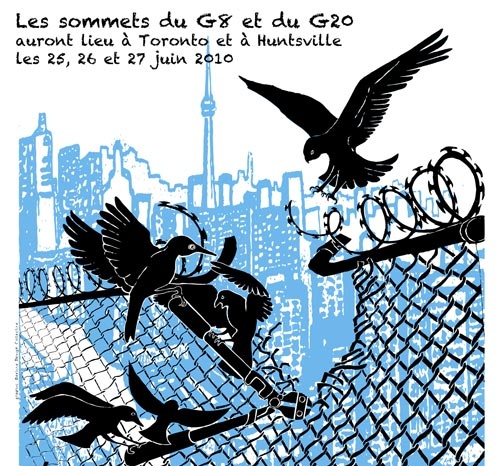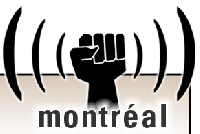 |
 |
 |
 |
 |
 |
|
 |
 |
 |
 |
 |
 |
 |
Régions du Québec |  |
 |
 |
|
 |
 |
|
 |
 |
|
 |
 |
 |
 |
 |
 |
Rubriques (sujets) |  |
 |
 |
|
 |
 |
|
 |
|
 |
 |
 |
As Free Trade Summit Nears, Borders Tighten
More than 13 million Americans traveled to Canada last year, and for
most of them, crossing the border was as simple as brandishing a
driver's license. But that was before the Summit of the Americas came
to town.
More than 13 million Americans traveled to Canada last year, and for
most of them, crossing the border was as simple as brandishing a
driver's license. But that was before the Summit of the Americas came
to town.
With President George Bush and 33 other national leaders scheduled to
descend on Quebec City on April 20, security forces across Canada are
on red alert. A three-mile long chain-link fence intended to separate
Summit delegates from tens of thousands of protesters is nearly
complete and now security forces are erecting a fence of another kind;
strict border measures that may keep thousands of protesters from
reaching the Summit at all.
Rumors have been rife for months that activists planning to protest
the Free Trade Area of the Americas agreement would be turned back at
the Canadian border. And as the date nears, Canadian immigration
officials appear to be doing just that.
A group of nine activists representing the New York City Direct Action
Network was turned back on April 1st, after background checks revealed
that several had arrest records from earlier globalization protests.
"They say that they are turning back people with criminal records,"
says Eric Laursen, who works with the group. "But it's more selective
than that. They're looking for activists, for any sign that you plan
to participate in the protests."
With this particular group, immigration officials at the Champlain, NY
border crossing didn't have to look too hard. Two of the protesters
were dressed as dollar bills, another as an enormous genetically
modified tomato.
But the tomatoes aren't the only ones getting squashed at the border.
Activist George Lakey, who was scheduled to lead a non-violence
training session in the Canadian Parliament earlier this month, was
held at the airport in Ottawa for hours, questioned by immigration
authorities. Only a barrage of media calls triggered by labor union
officials, says Lakey, got him into the country at all.
"I travel all over the world doing trainings like this," says Lakey,
who later participated in a protest at the Department of Foreign
Affairs, demanding that draft texts of the FTAA be released to the
public. "They spent hours searching for grounds to deny me entry. They
photocopied documents and e-mails. They went through novels I read on
the plane. It was like crossing through 'Checkpoint Charlie' in the
1960's."
While activists - and even some Canadian journalists - are crying foul
about the harsh border measures, Canadian law gives immigration
officials broad leeway when it comes to deciding who gets in and who
gets turned away. "There is a bit of interpretation going on at the
border," says Stephen McCammon, an associate counsel at the Canadian
Civil Liberties Association in Toronto. The Immigration Act, notes
McCammon, specifies a number of inadmissible classes, including
individuals who have been convicted outside of Canada.
But the officials aren't just looking for criminals of record. Those
who've been convicted of so-called 'mischief' charges, ranging from
destruction of property to occupying buildings, may also be turned
back. And if you haven't been found guilty of any of these offenses in
the past, border officials have the authority to predict whether you
are likely to be in the future. Evidence that individuals plan to
engage in so-called "subversive" acts against the government may also
be used as grounds for barring entry, says McCammon.
Still, while border officials may have the legal cover to turn back
thousands of protesters, experts question whether Canada really wants
to set such a precedent. Alan Borovoy, is the general counsel of the
Canadian Civil Liberties Union, and an outspoken critic of the massive
security measures underway in Quebec City. "It makes me very uneasy,"
says Borovoy. "It starts to look like they're keeping people out
because they plan to demonstrate. If this is what happens, it doesn't
just look bad politically and legally, it is bad."
Anticipating crackdowns at the border, activists are gearing up to
make the best of what is likely to be a very tense situation. Border
protests are planned across the country, and convergence centers,
intended to provide support for activists heading north, will soon be
up and running in Buffalo, NY and Burlington, VT. These students,
union members and protesters of all-stripes hope to be in Quebec City
on April 20, but if they're denied entry, they say, the border police
are proving the very point that they sat out to make in the first
place. "If we're not admitted," says Eric Laursen of the Direct Action
Network, "it highlights that the FTAA is an agreement that opens
borders to corporations and capital, but not to individuals who are
traveling from country to country. For us, the FTAA maintains a
rigidly closed system."
Thousands of activists from the Eastern Seaboard plan to make their
trip to Canada via a third country: the Mohawk nation of Akwesasne
that lies on either side of the US-Canadian border. A group of Mohawk
activists recently announced that they plan to escort protesters over
the Seaway International Bridge, an international crossing that lies
on Mohawk land. The activists hope that their gesture of solidarity
with anti-globalization activists will also focus some attention on
the problems faced by indigenous peoples - in Akwesasne and throughout
the hemisphere. "It's about asserting ourselves in a legitimate way,"
Mohawk activist Shawn Brant told the Montreal Gazette. "It's about
showing our opposition to the FTAA."
 |
 |
 |
 |
Dossier G20 |  |
 |
 |
|
 |
 |
|
 |
Nous vous offrons plusieurs reportages indépendants et témoignages...

Liste des activités lors de ce « contre-sommet » à Toronto Vous pouvez aussi visiter ces médias alternatifs anglophones... Centre des médias Alternatifs Toronto 2010.mediacoop.net Media Co-op Toronto http://toronto.mediacoop.ca Toronto Community Mobilization www.attacktheroots.net (en Anglais) |
 |
 |
 |
 |
 |
 |
 |
CMAQ: Vie associative |  |
 |
 |
|
 |
 |
|
 |
 Collectif à Québec: n'existe plus. Impliquez-vous ! |
 |
 |
 |
 |
 |
 |
 |
 |
|
 |
 |
 |
Ceci est un média alternatif de publication ouverte. Le collectif CMAQ, qui gère la validation des contributions sur le Indymedia-Québec, n'endosse aucunement les propos et ne juge pas de la véracité des informations. Ce sont les commentaires des Internautes, comme vous, qui servent à évaluer la qualité de l'information. Nous avons néanmoins une
Politique éditoriale
, qui essentiellement demande que les contributions portent sur une question d'émancipation et ne proviennent pas de médias commerciaux.
This is an alternative media using open publishing. The CMAQ collective, who validates the posts submitted on the Indymedia-Quebec, does not endorse in any way the opinions and statements and does not judge if the information is correct or true. The quality of the information is evaluated by the comments from Internet surfers, like yourself. We nonetheless have an
Editorial Policy
, which essentially requires that posts be related to questions of emancipation and does not come from a commercial media.


